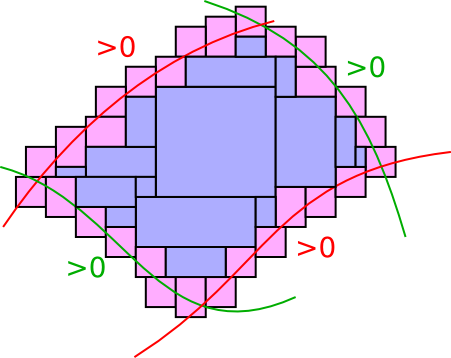Introduction¶
Ibex is a C++ numerical library based on interval arithmetic and constraint programming.
It can be used to solve a variety of problems that can roughly be formulated as:
Find a reliable characterization with boxes (Cartesian product of intervals) of sets implicitely defined by constraints
Reliable means that all sources of uncertainty should be taken into account, including:
approximation of real numbers by floating-point numbers
round-off errors
linearization truncatures
model parameter uncertainty
measurement noise

Example of problem: Given a set of nonlinear inequalities \(f_1\leq0,\ldots,f_n\leq0\), find two sets of boxes S1 and S2 such that
The API¶
The API of Ibex can be broken into three layers:
An extended (symbolic-numeric) interval calculator
A contractor programming library
A system solver / global optimizer
Each usage corresponds to a different layer and each layer is built on top of the previous one.
Ibex does not include low-level interval arithmetic but uses a third library (Ibex is currently automatically compiled either with Gaol or Filib , depending on your platform).
An extended interval calculator¶
Ibex allows you to declare symbolically a mathematical function and to perform interval computations with it. For example:
Variable x;
Function f(x,sin(x)+1);
defines the “mathematical” object \(x \mapsto sin(x)+1\).
Note: Functions (as well as equalities or inequalities) can either be entered programmatically (using C++ operator overloading) or using a parser of an AMPL-like language called Minibex. Functions accept vector or matrix variables or values; similarities with Matlab are shared on purpose. See the modeling guide.
Now that functions are built, you can use them to perform interval or symbolic operations. Example:
Interval x(0,1);
Interval y=f.eval(x); // calculate the image of x by f
Function df(f,Function::DIFF); // derivate f
Interval z=df.eval_affine(x); // calculate the image of x by df using affine forms
All the classical operations with intervals can be performed with the previously defined functions, including relational (backward) operators, inner arithmetics, automatic differentiation, affine arithmetic, etc.
Contractor programming¶
Ibex gives you the ability to build high-level interval-based algorithms declaratively through the contractor programming paradigm [Chabert & Jaulin, 2009].
A contractor is basically an operator that transforms a box to a smaller (included) box, by safely removing points with respect to some mathematical property.
The first property one usually wants to enforce is a numerical constraint, like an equation or inequality:
Variable x,y,z;
Function f(x,y,z,...);
NumConstraint c(x,y,z,f(x,y,z)=0);
CtcFwdBwd ctc(c); // build the contractor w.r.t f(x,y,z)=0
Contraction is performed with a call to the function contract(...):
IntervalVector box(3); // build a box for x, y and z
box[0]=...;
box[1]=...;
box[2]=...;
ctc.contract(box); // contract the box
Note: A contractor is the equivalent of a propagator in finite domain solvers except that it is a pure numerical function (no state).
More complex properties are obtained by combining contractors. For instance:
Ctc& c1=... ;
Ctc& c2=... ;
Ctc& c3=... ;
CtcUnion u(CtcInter(c1,c2),c3);
will define the contractor \(((C_1 \cap C_2) \cup C_3))\).
Ibex contains a variety of built-in operators (HC4, Shaving, ACID, X-newton, q-intersection, etc.).
System solving and global optimization¶
Finally, Ibex supplies two executables: IbexSolve and IbexOpt whihch are dedicated to system solving and optimization, and come both with a default black-box solver and global optimizer for immediate usage. See the IbexSolve and IbexOpt documentations.
Ibex proposes two top-level applications: IbexSolve and IbexOpt, which are dedicated to system solving and optimization respectively; they are both default black-box strategies for immediate usage. See the IbexSolve and IbexOpt documentations.
Finally, there exist plugins (or packages with cmake) that propose interesting extensions of the library, such as affine arithmetic, AMPL compatibility, semi-infinite programming, etc. Visit the ibex team page on Github.